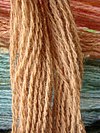Disperse dye
Disperse dyes are polar molecules containing anthraquinone or azo groups.[1][2] The history of disperse dye production is closely related to the synthesis of cellulose acetate fibres.[3] Disperse dyes are non-ionic in nature and partially soluble in water.The interaction of dye molecule and polymer takes place with Van der Waals and dipole forces.[4] Disperse dyes have better diffusion at boiling to a higher temperature.

synthetic dyepolyesteranthraquinone dyescellulose acetatenon-ionicsolubleVan der WaalsdipoleDisperse Bluecontact allergyDisperse Orange 1azo dyeDisperse Red 9anthraquinoneDisperse Red 11Disperse Red 60Disperse Yellow 26Disperse Yellow 42anilinebenzenesulfonyl chlorideUllmann's Encyclopedia of Industrial ChemistryDyeingKasuriKalamkariKatazomeLeheriaMordantReactive dye printingResistRing dyeingRōketsuzomeShiboriTie-dyeTsutsugakiYūzenNaturalReactiveSolventSubstantiveSulfurDischargePigmentArmenian cochinealBlack walnutBloodrootBrazilinCudbearDyewoodsFusticGambogeDyer's broomIndigoKermesLogwoodMadderPolish cochinealSaffronTyrian purpleUse of saffronTraditional dyes of the Scottish HighlandsInkodyeProcionGlossary of dyeing termsList of dyes